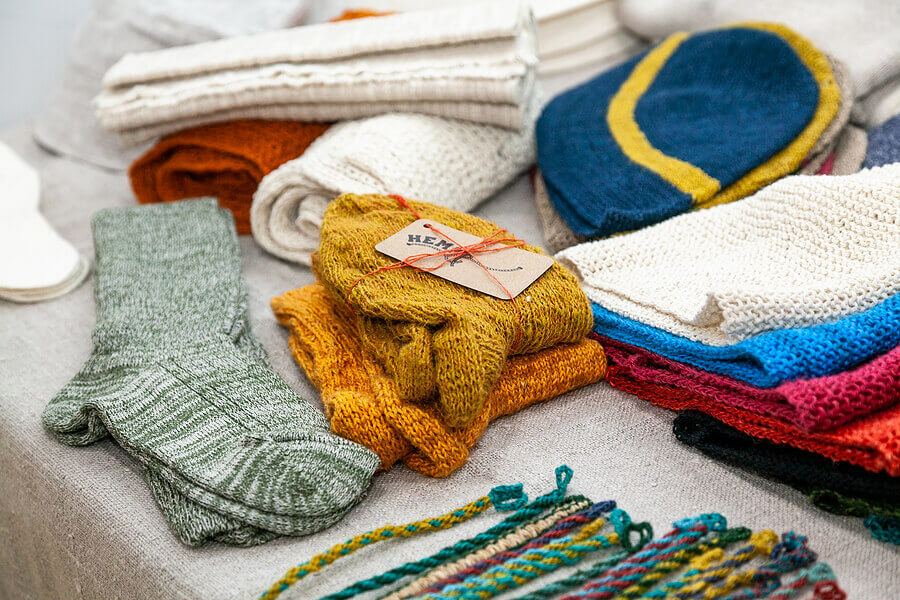Free Tips On Deciding On Bamboo Clothing
Wiki Article
Why Is Hemp More Durable, Regenerative And Bidegradable Than Cotton?
Hemp is more biodegradable than cotton, and is also considered sturdy. This is due to the inherent characteristics of hemp as well as the way it is cultivated. Here's why- Biodegradability-
Natural Fiber - Hemp is a natural plant fibre, that is biodegradable. Fabrics and clothes made of hemp are broken down with time. The waste is returned to the earth with no permanent negative effects. This contrasts with synthetic fibres such as polyamide, which degrade over a period of hundreds of years.
Hemp Textiles Lack Synthetic Additives They do not contain synthetic additives. Hemp fibers generally don't contain synthetic additives. Contrary to cotton fabrics, which might contain synthetic chemicals (such as dyes or finishers) that can inhibit biodegradation, hemp textiles do not.
Durability-
Fiber Strength- Hemp fibers are renowned for their durability and strength. Hemp clothing and textiles are more resistant to wear and tear which makes them more durable in comparison to cotton-based products. That means hemp clothes will last longer, even before it begins to show indications of wear and tear.
Hemp fabric is less prone to pilling which results in the formation of tiny, fuzzy balls that form on the fabric surface. This is a characteristic that enhances their overall quality and durability.
Regenerative Agriculture-
Soil Health- Hemp cultivation can be regenerative when it is done in a sustainable manner. Hemp cultivation sustainably is a deeply-rooted system that helps to help prevent soil compaction. This system of roots can also help prevent erosion. This regenerative component can help the soil be healthier to produce future crops.
Low environmental impact- Sustainable hemp cultivation techniques require the use of a minimal amount of pesticides. Cotton farming, which relies on synthetic chemicals can cause soil degradation as well as water contamination.
Water Efficiency-
Hemp typically requires less water than cotton. Its drought-resistant characteristics mean that it can thrive with minimal irrigation or in rain-fed environments. This makes the plant the ideal choice for those that have limited water resources for example, dry regions.
Hemp can be incorporated into crop rotations that improve soil health by reducing risk of disease and soil depletion. The practice of crop rotation in the cotton industry isn't as widespread.
The versatility of hemp allows it to be utilized in a variety of applications including textiles, clothing, paper and building materials. This flexibility implies that hemp cultivation could be used to support a variety of industries using sustainable and eco-friendly practices.
While hemp is a great product with many benefits however, it is crucial to remember that cotton and hemp can both be produced in a sustainable or unsustainable way, depending on processes and methods used to grow them. It is best to choose hemp products that are produced using eco-friendly and ethical practices. This will increase the benefits for the environment. Selecting organic cotton products will also help mitigate the environmental impacts of conventional cotton production. Follow the top rated continued for hemp clothes for website examples including hemp jeans, hemp mens jeans, hemp boxer shorts, patagonia hemp pants, hemp apparel, patagonia hemp shorts, hemp shirts wholesale, organic hemp clothing, hemp tees wholesale, hemp golf shirts and more.

What Makes Hemp Clothing More Useful And Technically Superior To Traditional Fibres Than Other Fabrics?
Hemp clothing offers a variety of advantages in terms of functionality and technological advancement over conventional fabrics, as well being more sustainable. Here are a few ways in which hemp clothing stands out as an eco-friendly, high-performance product for moisture wicking and breathability-
Hemp fibres are extremely air-tight. They also absorb moisture, which makes hemp clothing extremely comfortable in different weather conditions. They can help you stay dry and cool, and help to stop the growth of bacteria.
Temperature Regulation
Hemp clothing is extremely thermoregulating properties. It can keep you warm in cool temperatures by retaining heat close to the body. It also helps keep you cool in hot weather by allowing heat and moisture to be able to escape. The ability to regulate your body temperature naturally will help you stay away from frequent changes of clothes.
Longevity and durability-
Hemp fibers are renowned for their the durability. Hemp clothing is stronger and more able to wear than clothes composed of other fibers such as cotton. This makes hemp clothes last longer, thus reducing the need for replacements, and consequently, environmental impact.
UV Protection
Hemp fibers provide natural UV protection, protecting the skin from damaging UV radiation. This attribute is particularly useful for outdoor activities.
Biodegradability:
Hemp clothing is biodegradable, meaning it will break down naturally over time when disposed of. This reduces the pollution caused by textiles since synthetic fibers are suitable for landfills to remain.
Low Environmental Impact
Hemp cultivation typically requires fewer synthetic herbicides and pesticides when in comparison to cotton grown conventionally. Hemp also requires less water, making it an environmentally friendly option. These environmentally friendly characteristics are boosted through organic hemp farming.
Carbon Sequestration
When they grow, hemp plants can absorb carbon dioxide from the air. The hemp plant is able to act as a carbon sink and reduce greenhouse gases.
Crop rotation and sustainability-
Hemp is easily integrated into crop rotation systems to enhance overall soil health. It also lowers the chance of soil depletion or accumulation of diseases. This method of farming that is sustainable contributes to its eco-friendliness.
Versatility:
Blending hemp fibers with other materials such as organic cotton or recycled polyester can create high-performance, eco-friendly fabric blends. This versatility allows for the development of innovative and sustainable textiles.
Low Toxicity
Hemp fibers are low-toxic in nature and do not need any chemical processing during the manufacturing process, help reduce the environmental impact.
Apart from hemp's numerous ecological and functional benefits, it is important to remember that the sustainability of clothing may also be affected by factors like dyeing techniques, transportation, or ethical working practices. For consumers to make environmentally friendly choices they should look for brands that are committed to the environment, transparent manufacturing and ethical business practices. View the top rated the original source about hemp clothes for website recommendations including hemp mens jeans, hemp and cotton fabric, hemp yoga clothes, nomad hemp wear, hemp underwear, jungmaven t shirt, 100 hemp clothing, hemp shirts mens, patagonia volley shorts, hemp pants and more.

What are the differences between bamboo and hemp fibers?
Hemp and bamboo are two different plant-based fibers that are used in textile production, each with its unique characteristic and characteristics. Here are the major distinctions between bamboo and hemp fibers- 1. Plant Source-
Hemp- Hemp fibers are derived from the hemp stalks plant, particularly from the bast fibers that are in the outer layer. Hemp has been utilized to serve a variety of purposes throughout the years. Hemp is a rapid-growing multi-purpose plant.
Bamboo fibers can be made from the pulp produced by the bamboo plant. Bamboo is grass that grows rapidly and is renowned for its sustainability.
2. Fiber Characteristics
Hemp- Hemp fibers are recognized for their strength and durability. They are among the most durable natural fibers, and soften with each wash and are therefore suitable for durable textiles.
Bamboo bamboo is a silky, soft fiber. They are more fragile and less durable than hemp fibers but are still coveted for their softness against the skin.
3. Texture and Feeling
Hemp fabric is a bit coarse and has a rough feeling. This is particularly true in its natural state. It's comfortable, but has a distinct feel compared to bamboo.
Bamboo is silky smooth and soft. It's described as a mixture of silk and cotton, which makes it extremely comfortable to wear.
4. Breathability (and moisture-wicking)-
Hemp- Hemp fibres are naturally water-wicking, breathable and allow air circulation. They absorb moisture and allow for air circulation. They help keep you cool and dry in hot temperatures.
Bamboo- Bamboo fibers are also very humid and breathable. They also have a moisture-wicking. They're stocked with micro-gaps, which increase their capacity to regulate the temperature and moisture.
5. Environmental Impact-
Hemp- Hemp fiber is an eco-friendly product due to its low requirement for water, rapid growth as well as its resistant against pests. This means that it is less need for pesticides and herbicides. Hemp can absorb CO2 out of the atmosphere as it expands.
Bamboo is known as a sustainable material. It is fast growing, requires only a small amount of water, and can be grown without chemical herbicides or pesticides. Some bamboo varieties, like Moso bamboo, are very eco-friendly.
6. Processing-
Hemp- Hemp fibers must be thoroughly processed in order to separate the outer bast fibers from their inner core. Processing may involve the process of retting (decortication), mechanical separation, or the process of retting.
Bamboo- Bamboo is usually produced by a chemical method known as the viscose-or rayon-process. This involves breaking down the bamboo pulp by using chemical. This can be damaging to the environment if it is not handled responsibly. However, some bamboo textiles employ closed-loop systems that reduce chemical waste.
7. Versatility-
Hemp- Hemp fibres can be used for a range of uses, including clothing, textiles, and paper. They also make excellent building materials.
Bamboo- Bamboo is mostly used in the production of textiles and clothing. But, it may be used in other products such as bed linens and towels.
Both bamboos and hemps have advantages in terms of sustainability and unique characteristics. The choice between them is based on the qualities you are looking for in a textile and also your preference for the environment. Take a look at the recommended bamboo clothing for more advice including jacket bamboo, bamboo brand jeans, bamboo clothing brand, bamboo apparel wholesale, bamboo athletic wear, kyte pajama, bamboo athletic wear, bamboo sports clothing, ladies bamboo pants, bamboo pants ladies and more.
